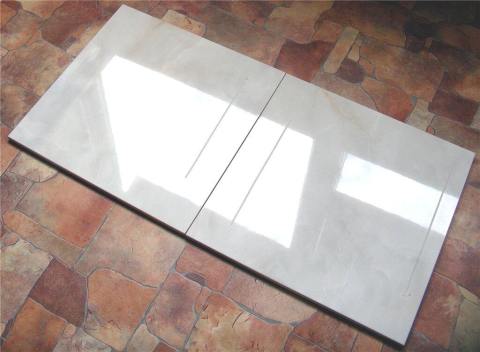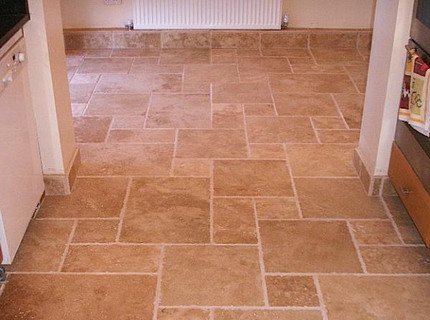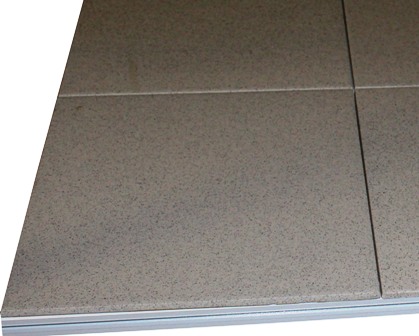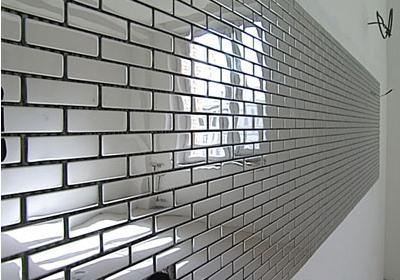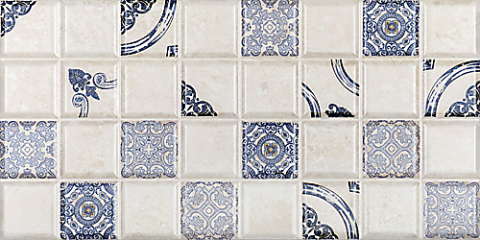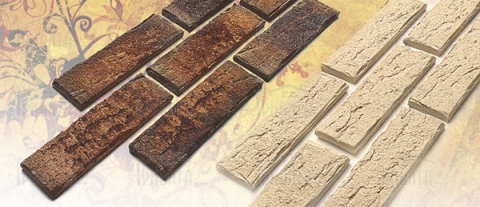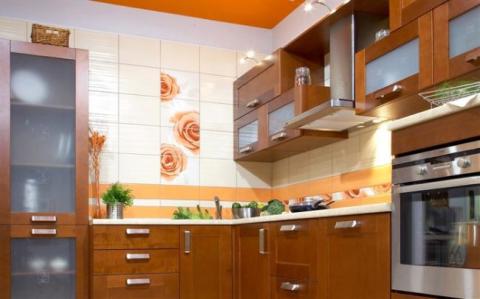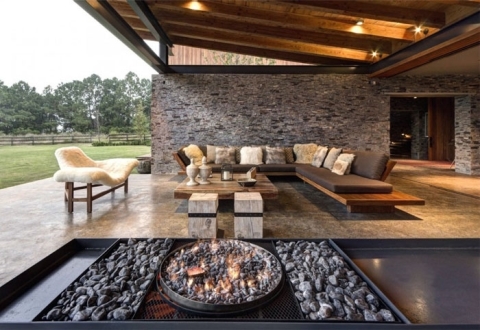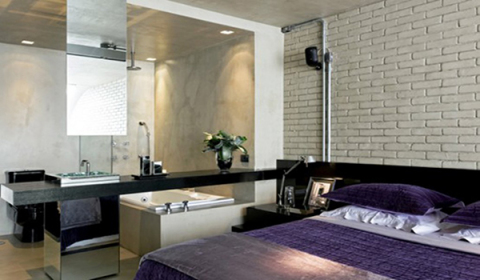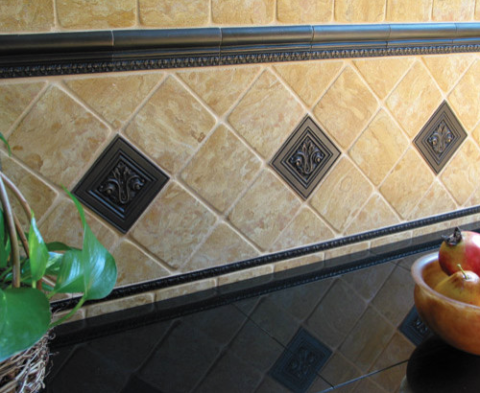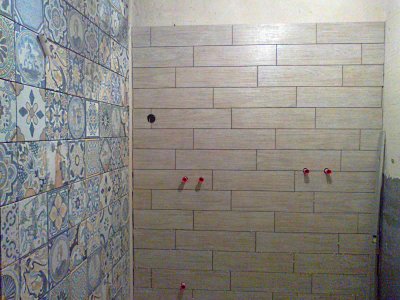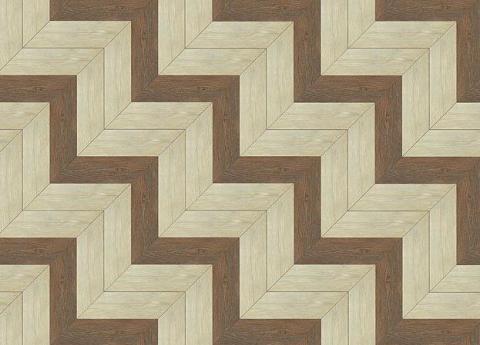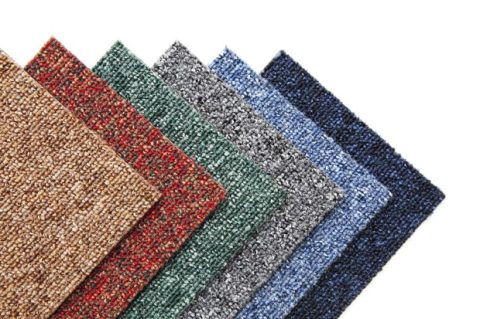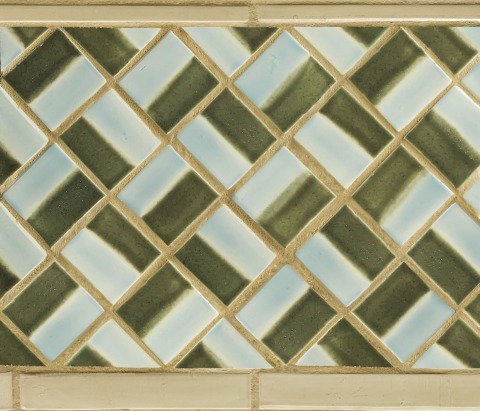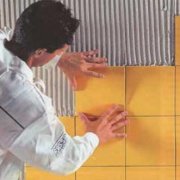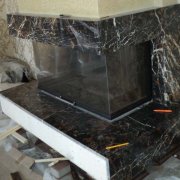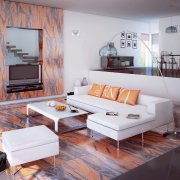Tiles on the wall - the variety of options will not leave anyone indifferent
The tile that sticks to the wall can be quite different types. It is different in the material of manufacture and, accordingly, in its characteristics. So here, first of all, the purpose of the room and the environment will matter. Indeed, in an unheated room, the material must tolerate only temperature changes, but also increased humidity. Also, the tile should be chosen according to the style of the room itself.
Today we will study this issue in detail, you will find out what the retail chains offer and in the photo and video in this article you can also see design options.
The content of the article
Making a tile choice
Wall cladding is distinguished in connection with the types of surfaces on which it will be applied:
Glossy tile option | With a smooth surface, it is able to reflect directional light. At the same time, maintaining such a tile is a rather complicated process. Stains from soap and other cleaning products, as well as all kinds of stains on it, stand out clearly. Mirror tile on the wall is mainly done in this version. |
Matte tile option | This type does not require much care and gives the interior room coziness and excellent appearance. The tile under the tree on the wall is mainly done in this version. |
Embossed Tile Option | The appearance of this variety is decorated with an ornament or pattern made using embossing. Embossed tiles can be glossy and matte. |
The tiles used to cover the walls are divided by the shape of the edge into a straight line or universal. If the tile material has a straight edge, it is laid with plastic crosses, which serve to fix the constant width of the tile joints. That is, in this case, the seams are the same in width. The wall covering with a universal edge is attached to the walls end-to-end, without seams.
Tile Choices
Wall tiles can be made of different materials.
Based on this, several main types are distinguished:
Ceramic Tile Option | This is one of the common materials. It gained its popularity due to two main characteristics: durability and an impressive service life. In addition to properties, ceramics has another important advantage: the range of shades, shapes, patterns, prices is so wide that it can satisfy the desires of any customer. Ceramics are indispensable for working in kitchens, in pools (seeTiling the pool: finishing methods), work offices, etc. |
Porcelain Tile Option | The surface of this variety is very similar to glass, but in fact it is quite durable, chemical and impact resistant. The appearance of the tiles is in perfect harmony with the interior of any kitchen and bathroom (seeFinishing a bathroom with tiles: material selection and installation), and the variety of colors allows it to match even the most daring design decision. |
Porcelain Tile Option | It stands out among the other types of wall tiles with high resistance to any kind of impact. The granite surface imitates natural materials such as marble, granite and many others. This type of cladding will be a wonderful decoration in the living room or fireplace with a thematic design. |
Mirror Tile Option | Mirror wall tiles, in spite of a very spectacular appearance, are not suitable for rooms or offices (seeModern design and office decoration), in which a high degree of humidity. Often, mirror tiles are used in conjunction with other materials used for decoration. |
Majolica tile option | This type is made in sunny Italy from sand clay. There is a glaze on the surface of the material. It is worth noting the high strength index of majolica, which is achieved by double firing during production. |
Terralia tile option | In high demand, this cladding material is made from a special grade of clay, in which flux and sand are added. Such a tile is environmentally friendly, since a special technology is used in the manufacture, in which the material is fired twice. |
Cotto Tile Option | Tiles made from rare types of clay are well suited to carry out finishing work where it is very humid. The surface of the cotto is not covered with glaze, this tile has a matte surface. As a rule, this tile is used when working in bathrooms, saunas. |
Clinker tile option | This variety stands out for its service life, which is several decades. Such indicators are achieved due to the fact that during the production process the material is exposed to high temperatures. This feature provides clinker tiles excellent moisture resistance and durability. It is used to repair any premises. It is often done under a brick, and you can imitate this material. |
We select according to the characteristics
Types of tiles interact differently with external factors (humidity, various temperatures, physical and chemical effects). Therefore, choosing wall tiles for your home, you must carefully familiarize yourself with the characteristics that the material possesses.
It:
| Heat resistance | Temperature differences affect any finishing material, including wall tiles. This influence factor is most actively manifested when working in showers and bathrooms. Here, swings from strong heat to room temperature are not uncommon, therefore it is necessary that the tile has high heat resistance. High-quality glazed tiles can withstand temperatures up to +125 degrees. |
| Quality characteristics | They are determined by the type of tile and its appearance. The surface of high-quality tile material eliminates any cracks, cavities and bubbles. The inside of the tile must be even in color. Defects at the edges, such as all kinds of chips or curvature, are also considered unacceptable for a quality made material. |
| Strength and Chemical Resistance | When decorating walls, do not always give preference to thick and heavy materials with the highest density. The average thickness varies from 3 to 4 millimeters, but this parameter does not exclude the possibility of mechanical damage if the installation was carried out by the correct method. Durability and resistance to household chemicals - these are the characteristics that necessarily prevail in quality tiles. According to this criterion, the material is labeled as A, AA, B, C, D. In particular, for the bathrooms AA lining is perfect, and when finishing the kitchen, it is better to use type A tiles. |
| The size | Choosing tiles according to this characteristic is necessary, based on the area of the room in which the finishing work will be carried out. In different collections, the size of the material varies from 10 × 10 cm to 60 × 60 cm.In the construction markets, the popularity of square tiles fades away, and products with a wide variety of lengths come out on top. There are many sizes, but the most common models are 200 × 400 mm, 200 × 250 mm, etc. The growing popularity of such tiles is explained by the fact that its use allows you to fully realize any, even the most daring, design decision. |
The choice of wall tiles depending on the purpose of the room
Tile is one of those materials that are selected once and do not change over the long term. Therefore, before you start browsing the assortment of stores, you need to know which tile will be the best solution for the room where the facing works are planned.
According to the functional value of the room are divided into:
- Bathroom, bath, shower. To finish them, you need to use a tile with a high moisture resistance. This is a tile material belonging to the first class and characterized by its hydrophobicity, that is, the rejection of water. Note that the bathrooms are well suited to implement an interesting solution - the use of mosaic styling.
- Kitchen. When choosing a finishing material, you need to take into account the chosen style in which the kitchen space will be executed. Tiles are perfect for walls where the sink and stove are attached, as well as for the entire kitchen. The main parameters for the selected tile are protection against moisture and high temperature characteristics. It is also important that the tiles can be cleaned using household chemicals without danger of damaging the surface of the cladding.
- Terraces, hallways and loggias. These rooms are located on the verge of apartment space and the street, so they are threatened by exposure to dampness, dirt, and street dust. Therefore, the most common facing material in this case is ceramic tile and porcelain tile.
- Their advantages are high wear resistance and the fact that the materials are resistant to dirt. Often, the walls of the hallway are not decorated over the entire height and ends with a border that serves as decoration and decoration.
- When decorating loggias, terraces, tiles of light colors that imitate natural materials: stone, wood, etc., are perfect for use.
- Living quarters, study rooms, spacious halls. In most cases, the decoration of these rooms is refused. But popular designers often use it in the design of rooms in modern design styles. Wall tiles are often combined with a fireplace, in the compartment with which it creates a special atmosphere of comfort.
- Bedroom. To give the interior of the bedroom a certain luxury and bohemia, you can use tiles that mimic glass, metal or valuable natural materials. The presence of columns and ledges can be competently supplemented with mirror tiles, which will give the room a multifaceted and unusual look.
Attention: Wall cladding in a small room is best done with glossy tiles of light shades with mother of pearl.
This kind of material will not create problems for its care, and dried water stains and streaks on the surface are almost indistinguishable. In addition, due to the light-colored tiles, it will visually increase the space of the room.
How to tile
Often the solution, which is suitable for working with tiles, is laying in parallel. This is the main mistake of the majority of people who have chosen this way of finishing, because in the case of a competent selection of the size of the material, the interior of the room will take on a more aesthetic appearance, and also hide all the bumps and other defects.
To avoid mistakes when laying tiles on walls, you need to know the following subtleties:
- For spacious rooms, it is worth using large material, and in small rooms - products of small sizes.
- Using a mosaic with an interesting relief pattern, you can give the space more spaciousness.
- If the wall drawing is planned as one-piece, you need to use a seamless method of decoration and rectified ceramic tiles, in which there are no rounded corners.
Tile Laying Options
In addition to the traditional methods of facing, there are several less popular, but not at all inferior in beauty and originality methods of laying:
Laying tiles diagonal | It is often used to visually increase the volume of a room with non-parallel walls, which is achieved using light or glossy tiles. |
Deck laying | To create the effect of a brick wall, this method of laying should be used. It will achieve an effective look of any room. The facing material in this case is a rectangular boar tile. |
Christmas tile laying | Combining the two previous techniques, this method is quite complicated to perform, but has an impressive appearance. |
Carpet styling | Facing is carried out by laying tiles around the perimeter of the selected fragment of the wall. In this case, the multi-colored material is used, which ultimately leads to a beautiful carpet pattern on the wall. |
Mesh Tile | A composition is created from tiles of different colors and sizes, which will be repeated during subsequent diagonal or parallel laying of tiles. The result will also be a spectacular wall pattern. |
Any tile can be laid in any of the above options, and moreover, with your own hands. For laying each type there is a detailed instruction on the pages of our site. Then the price will be lower and the quality of the masonry you can do at a height.

